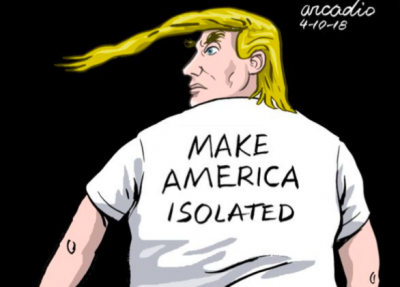China’s Petro-yuan “Becomes Real”: India Joins International Group Dumping US Dollars in Oil Trades to Bypass US Sanctions

When Donald Trump’s administration decided to withdraw from the Iran nuclear deal, the goal was to partner with allies to push Iran to negotiate a new agreement through even tougher sanctions. The new agreement would cover nuclear activities as well as ballistic missiles and destabilizing Iranian activity in Syria, Yemen and beyond.
World leaders in Asia and Europe, in particular, are reasonably sure that Washington really wants to see the collapse of the Iranian regime in order to control oil flows.
This was an arrogant miscalculation by Washington used to bullying its way around the geopolitical chessboard.
In 2015, under pressure from US sanctions, Russia decided to make moves to drop the USD on oil transactions. Gazprom Neft, the third-largest oil producer in Russia, moved away from the dollar and towards the Chinese yuan and other Asian currencies.
On March 26 this year, China finally launched a yuan-dominated oil futures contract. Over the last decade there have been a number of “false starts,” but this time the contract got approval from China’s State Council.
With that approval, the “petroyuan” became real and China set out to challenge the “petrodollar” for dominance. Adam Levinson, managing partner and chief investment officer at hedge fund manager Graticule Asset Management Asia (GAMA), already warned last year that China launching a yuan-denominated oil futures contract will shock those investors who have not been paying attention.
Paying attention is what those very same investors are now doing.
Already, the petroyuan has proven successful. 15.4 million barrels of crude for delivery in September changing hands over two and a half hours in its first day of trading.
With Washington’s withdrawal from the Iran nuclear deal, the EU27 backed by Britain decided enough was enough and concentrated efforts to protect business to side-step US sanctions for trading with Iran.
Then comes the news yesterday that India will reportedly pay for Iranian oil in rupees as the two countries seek to bypass the US economic pressure on Tehran.
China is the world’s biggest buyer of oil. America is the second and India is the third. Whilst the USA buys about $110 billion of oil each year – China and India combined – buys nearly $200 billion. The EU including Britain buys another $200 billion.
On oil trades – America is outgunned by the combined weight of its competitors.
These moves will not cause the USD to crash as about 88 per cent of the average daily turnover of foreign exchange instruments is against the dollar.
It took the US dollar nearly a century to unsettle the British pound that had been enjoying its preeminence through the 19th century and the first half of the 20th as the global reserve currency.
However, Washington may well be reeling from the fact that they don’t really have many friends any more.
The loosening of the U.S.-Europe transatlantic alliance is now forcing the EU to find its feet as a more independent superpower. The EU has new, economically driven allies on its side and America is facing even more challenges as it attempts to flex muscle and push back – no doubt starting with an escalating trade war.
*
Featured image is from TruePublica.

